| Vintage Pulp | Jan 27 2022 |

Tall and tan and young and lovely, and when she betrays them, each one she betrays goes, “Argh...”
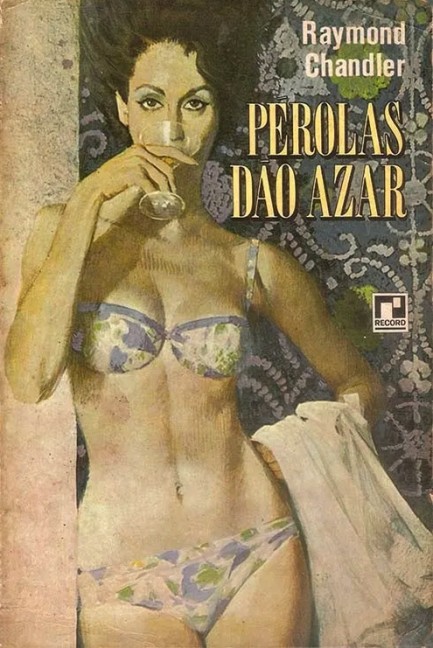
This interesting piece of art was sent to us by a friend, Leonardo, and it comes from Brazilian publisher Record for Raymond Chandler's Perolas dao azar. The book comprises three Chandler stories, “Pearls Are a Nuisance,” “Finger Man,” and “The King in Yellow,” plus his crime essay, “The Simple Art of Murder.” If you're an avid reader of old literature, “The King in Yellow,” may sound familiar. It was the name of an 1895 anthology by Robert W. Chambers, the best-selling U.S. author of the latter half of the nineteenth century, and the source of certain motifs used in H.P. Lovecraft's Cthulhu Mythos. Chandler's story isn't supernatural, but it does allude to Chambers' work.
The cover art is by Robert McGinnis and was previously used on Shell Scott's 1971 novel Dig That Crazy Grave. Around then Record began spicing up some of its paperbacks with McGinnis art. We don't know if he was compensated for his work. We've talked about this issue before, but long story short, we just can't see an economic win for Record in buying McGinnis's art. In a country as big as Brazil some artist could have painted a nice cover—and cheaply. Probably more cheaply than licensing art from McGinnis. We don't know how it all worked, so we're not saying Record stole the art, but still, you have to wonder. Thanks for sending this over, Leonardo.
The cover art is by Robert McGinnis and was previously used on Shell Scott's 1971 novel Dig That Crazy Grave. Around then Record began spicing up some of its paperbacks with McGinnis art. We don't know if he was compensated for his work. We've talked about this issue before, but long story short, we just can't see an economic win for Record in buying McGinnis's art. In a country as big as Brazil some artist could have painted a nice cover—and cheaply. Probably more cheaply than licensing art from McGinnis. We don't know how it all worked, so we're not saying Record stole the art, but still, you have to wonder. Thanks for sending this over, Leonardo.
| Vintage Pulp | Jan 17 2022 |

Raquel makes everyone a little bit happier.
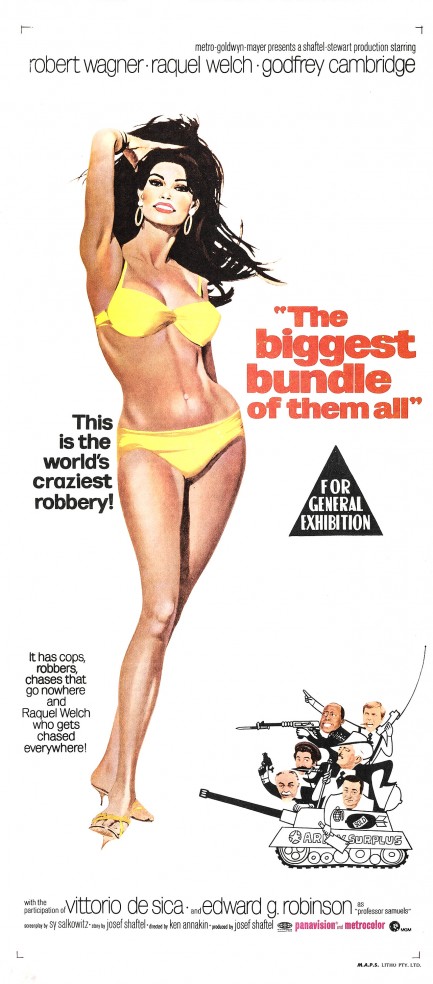
There's no discussion of mid-century cinema without Raquel Welch. She burst onto the scene in 1964 mainly on television, but by 1966 was a major silver screen presence. She was far more famous than the quality of her films would otherwise have warranted, but her beauty and bod helped make her a superstar. The above poster for The Biggest Bundle of Them All is an example of what movie studios usually sold: Raquel with a smile, preferably in a bikini. This promo was painted by Robert McGinnis in his trademark elongated style, and you see the naked art below, reversed from the poster but in its original orientation. Often the only available versions of these vintage pieces contain graphics, inextricable except by enterprising modern people using Photoshop or Gimp, but clean McGinnis originals survive for quite a few of his commissions, making his artistic ability all the more evident. You can see examples here and here, as well as on this website dedicated to him. We talked about The Biggest Bundle of Them All a while back. Shorter version: Raquel drives Italy wild. It premiered in the U.S. today in 1968.

| Vintage Pulp | May 18 2021 |

What is it with men? Why can't I find one who likes cats?
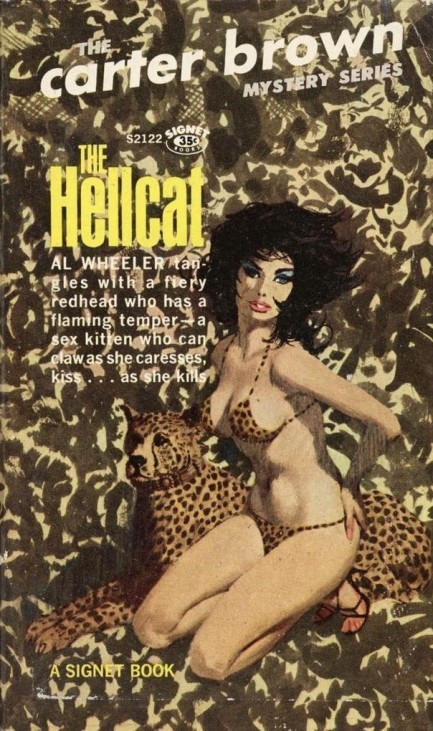
Like clockwork we return to master illustrator Robert McGinnis, as any paperback art site must. Here you see a cover for The Hellcat by Australian author Carter Brown, aka Alan Yates, for Signet Books, 1962. We showed you a Dutch cover for this years ago, which you can see here.
| Vintage Pulp | Feb 18 2021 |

When ragtag crooks hook up with a bevy of Bahama mamas a tropical storm breaks.
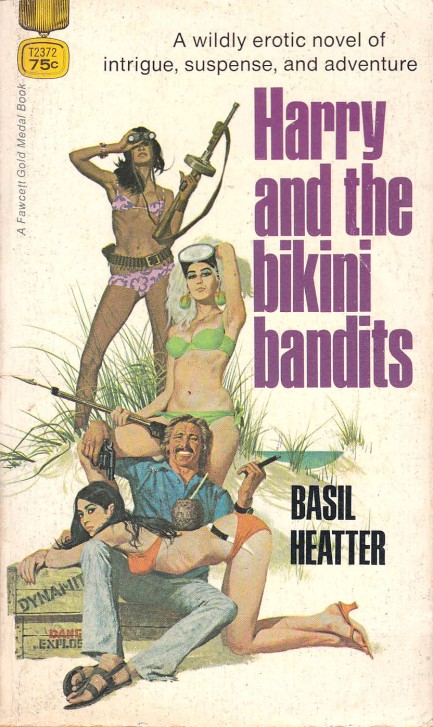
Basil Heatter 1963's novel Virgin Cay was an enjoyable tale, so when we saw this Robert McGinnis cover for Harry and the Bikini Bandits we couldn't resist. The novel, which came in 1969 with Fawcett/Gold Medal's edition appearing in 1971, is the story of seventeen-year-old Clayton Bullmore's trip to the Bahamas to see his nutty uncle Harry, who lives on a raggedy ketch and has a magic touch with women of all types. This is where the bikinis come in, but the bikini-wearers are not the bandits (except, technically, one). The bandits are Harry, a couple of his acquaintances, and Clay, who's dragged into a scheme to rob the big casino in Nassau. The combination of coming-of-age story and casino caper is fun, and Heatter mixes in humor, sex, and action, and folds it all into a winning waterborne milieu. He even manages to add a shipwreck, a deserted island, and buried treasure, so we'd say he includes all the most beloved tropes of tropical adventures. It'll make you want to run away to the Caribbean. Heatter is two-for-two in our ledger.
| Vintage Pulp | Jan 14 2021 |

You want me to be a good girl? I can do that. But it'll cost you extra.
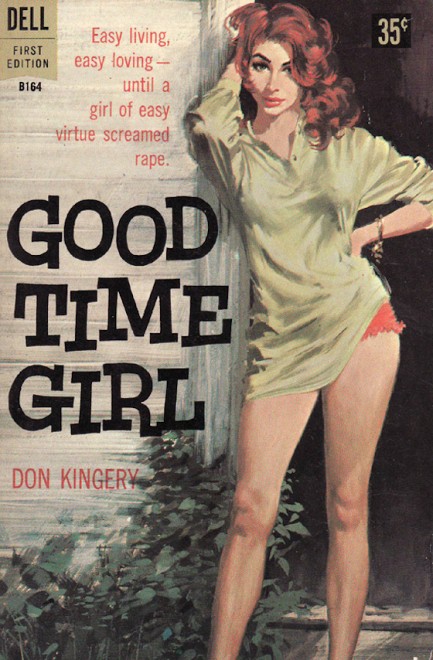
We run into Robert McGinnis everywhere. In fact, we suspect his art is so collectible that his covers are the reason some vintage paperbacks avoid oblivion. But Don Kingery's Good Time Girl, though obscure, deserves to survive on its own merits. It's a good book. The story, which is set in a small Louisiana town called Bay Ste. Marie, deals with a journalist named Jack Candless who agrees to push a false story of rape in order to advance his flagging career. The alleged victim is the town prostitute, but Candless helps make her over into a virginal good girl. The whole scheme is supposed to last only a few days, but of course it spirals completely out of control—not least because Jackie blue is a blackout drunk. This isn't the first time we've read Kingery, and it certainly won't be the last. Good Time Girl is confidently written, compellingly plotted, interestingly peopled, emotionally believable in terms of alcoholism, and has a convincing sense of place that makes clear Kingery knows the dirty south well. Top marks.
| Vintage Pulp | Jan 8 2021 |

The Devil went down to Southeast Asia looking for fortunes to steal.
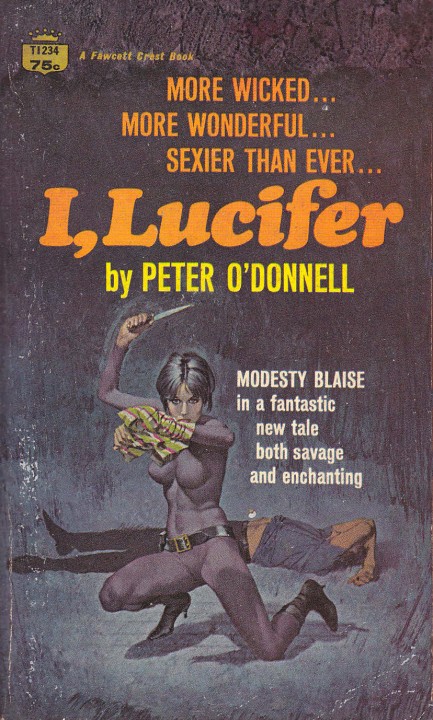
1969's I, Lucifer is Peter O'Donnell's third Modesty Blaise novel, and it's a series we're going through mainly to highlight the great cover art by Robert McGinnis. He didn't illustrate all the books. In fact, this might be the last, which means we'll probably move on to other authors. But that won't be because the Blaise books aren't good. In fact, for the sexy spy genre they're top notch—exotically located, compellingly plotted, and peopled by wacky Bond-style supervillains. Case in point: the titular character in I, Lucifer is a man suffering from a psychotic delusion that he's Satan. The funny part is he isn't evil. The real evil guy is Seff, the opportunist who launches a global extortion scheme that hinges on faux-Lucifer's participation even though his delusion prevents him having a clue what he's really doing. Lucifer might be the only villain we've encountered in a novel who's a victim.
When Seff's murderous extortion hits too close to home for Modesty, she and sidekick Willie Garvin gear up and eventually end up in the Philippines, where they right some wrongs, explosively. As usual Modesty uses sex to get over on the bad guys, and it's a major part of what readers enjoyed about the series. At one point she ponders whether a colleague thinks she's promiscuous. Well, no, she isn't by 1969 standards. But the joy of literature is she can be unpromiscuous, yet we can be there in the room for every one of her widely spaced encounters. This book is particularly amusing along those lines, as it brings two of Modesty's lovers together to be uncomfortable and/or jealous as they're displaced by a third. But sleaze fans will need to look elsewhere. O'Donnell is subtle—if not poetic—with his sex scenes.
Though the sexual aspects of Modesty Blaise were a major attraction of the novels, we enjoy even more the tactical nature of O'Donnell's action, which is probably an influence from his military service in Iran, Syria, Egypt, Greece and other places. It's also probably why so much of the Blaise series is connected to that region. While the tales are always exotic, this entry is even wilder than usual. How wild? It involves precognition, trained dolphins, Moro mercenaries, and body implants that kill remotely, yet it all works. That's because as always, in the center of the chaos, you have Blaise and Garvin, perfect friends, platonic soulmates, and two armed and extremely deadly halves of a razor sharp fighting machine. Abandon all hope ye who cross them.
| Vintage Pulp | Oct 17 2020 |

So I couldn't help noticing all the notches on your bedpost. What are those about?
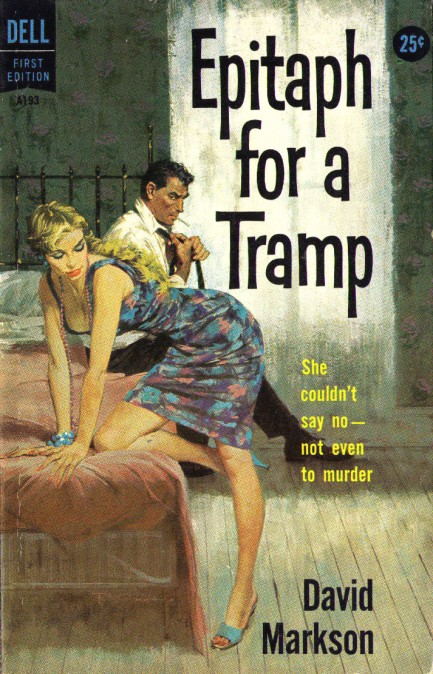
Today we have more elongation for you from the brush of grandmaster illustrator Robert McGinnis. This cover for the 1959 thriller Epitaph for a Tramp features one of his deliberately out-of-proportion femmes fatales, with a long lower half and a small head. He would stretch his girls to freakish lengths as time went by, but we especially like this phase from him. For an example of how unusual his women would get, check out these four examples we shared a while back. And if those intrigue you, there are also numerous examples of later McGinnis on the website of Hard Case Crime, with the best ones appearing here, here, and here.
Epitaph for a Tramp was written by David Markson, and the story involves a detective who finds himself drawn into danger when a mortally stabbed woman staggers through his door and dies. She's the tramp of the title, a woman who in one year of marriage cheated on her husband with—count em—thirteen men. Her cuckolded husband is occasionally sympathetic toward her, which is a bold writerly move for a period when most people—male and female—subjected women to ugly judgments for perceived sexual availability. But Markson was an ambitious author who would go on to become a celebrated literary figure with tales such as This Is Not a Novel and the acclaimed Wittgenstein's Mistress.
Here he does hard-boiled with a cleverness of phrasing that's rare, but often misses the mark too. For example, quips like, “Bare lightbulbs helped the hallway look like something other than the esophagus of a submerged whale,” just don't work. Sometimes a dim hallway can just be a dim hallway. But the story is reasonably interesting and the main character Harry Fannin fits the private dick mold well. As he tries to unmask a murderer he also unmasks a complex, troubled victim, a character who in our experience is unique in mid-century fiction. That's worth a lot, even if the book isn't perfect. We'll see if Markson did better with his second detective entry Epitaph for a Dead-Beat.
| Vintage Pulp | Sep 27 2020 |

Good thing we're in a district that opted for in-person classes. This wouldn't be nearly as pleasurable via Zoom.
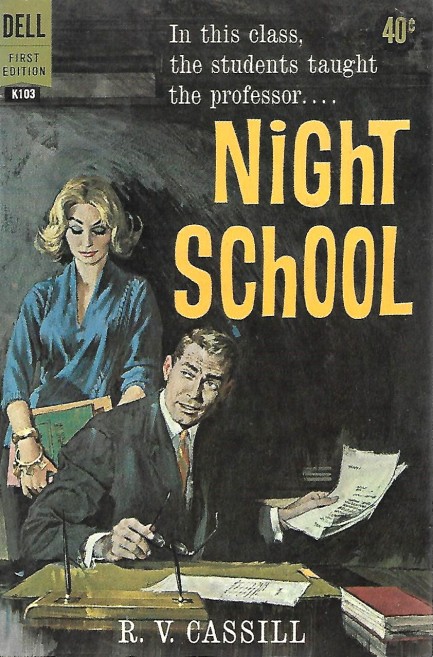
With R.V. Cassill's 1961 novel Night School we return once again to the time-honored pop fiction subject of teachers engaging in extracurriculars with students. Such affairs are nearly always frowned upon in these books, so don't go thinking these explorations represent any sort of endorsement. The authors generally come up with creative ways to get their protagonists into (and sometimes out of) seriously deep shit.
But as it turns out Night School isn't even teacher sleaze. It deals in serious fashion with a once-acclaimed novelist whose run of recent hard luck finds him teaching a dead end night school course where he must deal with an assortment of students and their various issues. There's sexual content, but not much. Sleaze novels can be quite fun, but there's little more disappointing than a novel that promises then doesn't get there.
But we weren't actually surprised Night School was more literary than the teaser suggests, because the legendary Robert McGinnis—the cover artist here—has never to our knowledge had his work front a sleaze novel (his romance covers don't count). We've shared several teacher sleaze covers over the years. If you want to see the best examples look here and here. And here too.
| Vintage Pulp | Sep 2 2020 |

The deeper you go into this casino the wilder it gets.
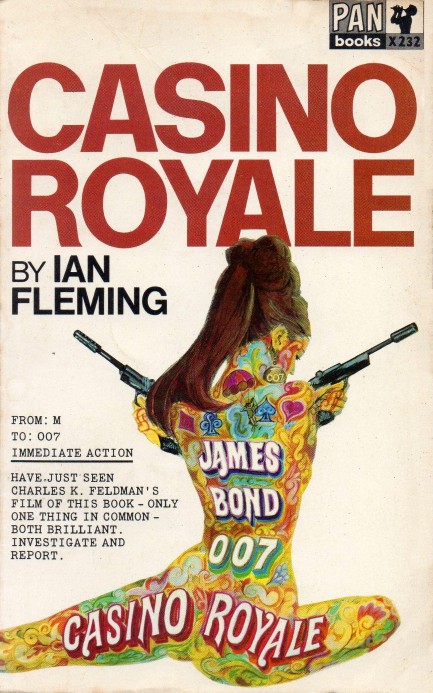
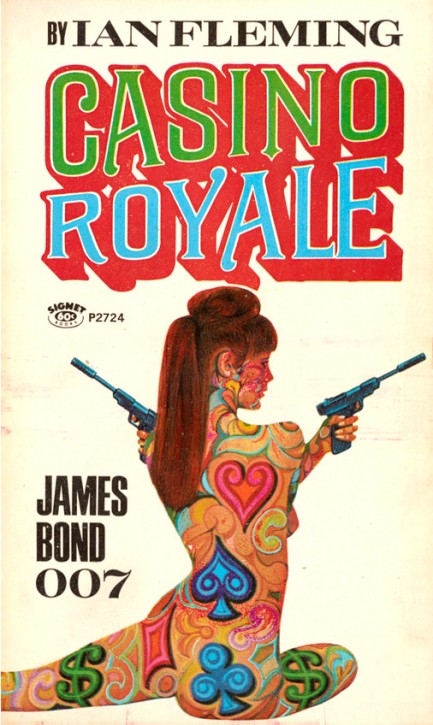
Today we're circling back to James Bond—as we do every so often—to highlight these movie tie-in editions of Ian Fleming's Casino Royale. The movie these are tied into is not the 1963 original with Sean Connery, but the 1967 screwball version with David Niven as Bond and Woody Allen as Bond's nephew Jimmy Bond. If you haven't seen it, just know that it was terribly reviewed, with Time magazine calling it an “an incoherent and vulgar vaudeville.” These covers are derived from the Robert McGinnis Casino Royale movie poster, which is an all-time classic. McGinnis created two versions of the poster—one with text and one without, with the painted patterns on the female figure varying slightly. You see both of those below.
The paperback was published by both Great Pan and Signet, and the cover art was different for the two versions. The Great Pan version at top is McGinnis's unaltered work, but the Signet version just above was painted by an imitator, we're almost certain. We'd hoped to answer this for sure by visiting one of the numerous Bond blogs out there, but none of them have really discussed the difference between the 1967 paperback covers. That leaves it up to us, so we're going to say definitively that the Great Pan version was not painted by McGinnis. Whoever the artist was, they did a nice job channeling the original piece, even if the execution is at a much simpler level.
Moving back to the posters, if you scroll down you'll see that we decided to focus on the details of the textless version to give you a close look at McGinnis's detailed work. The deeper you go the more you see—dice, poker chips, glittery earrings, actor portraits, and more. If you had a huge lithograph of this on your wall and a tab of acid on your tongue, an entire weekend would slip past before you moved again. This is possibly the best work from a paperback and movie artist considered to be a grandmaster, one the greatest ever to put brush to canvas. If anyone out there can tell us for sure who painted the Signet paperback—or whether it is indeed McGinnis—feel free to contact us.
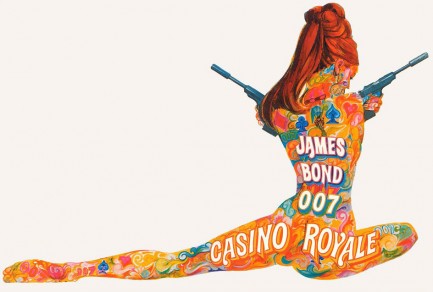
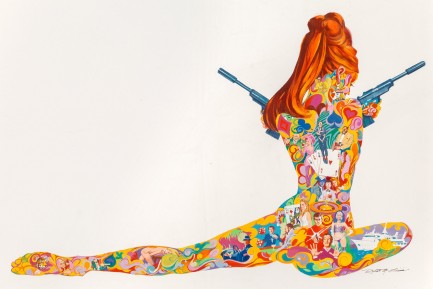
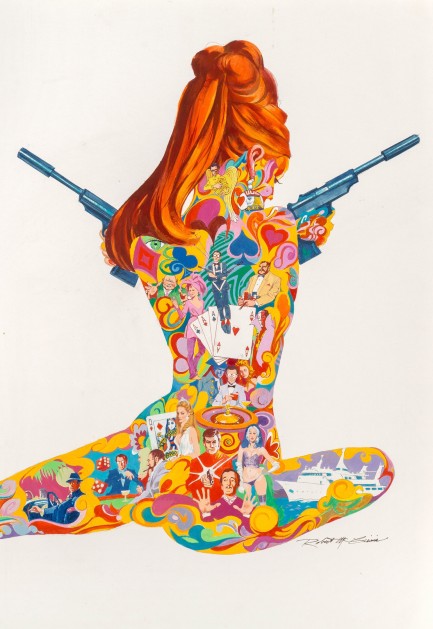
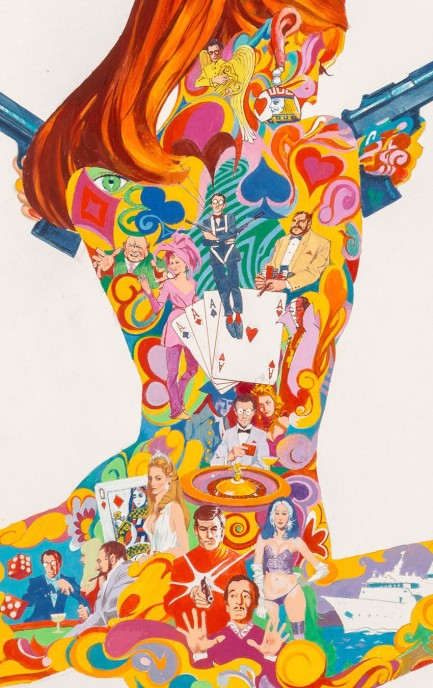
| Vintage Pulp | Aug 12 2020 |

Hollywood gets wholly weird in Bill Gault's show business thriller.
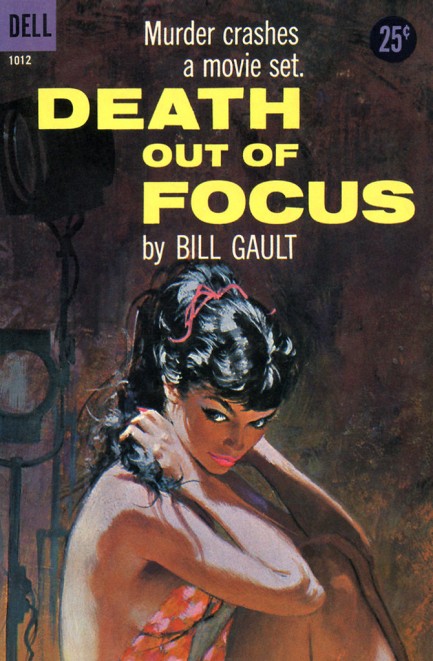
With Death Out of Focus, which is our third reading of Bill Gault, aka William Campbell Gault, we're thinking he can be moved into the trusted bin. He once more documents the decadent ins and outs of Southern California, this time centering his tale around a movie production. When director Stephen Leander's leading man ends up in the wreckage of his car at the foot of a cliff in Pacific Palisades and police call it an accident, a determined insurance investigator launches his own inquiry and begins turning up what looks like evidence of murder. Leander joins forces with the insurance guy to uncover the truth. Fun to read, quick of pace, and quirky the way a Hollywood thriller should be, Death Out of Focus takes various Tinseltown archetypes—the aging actress, the tyrannical producer, the sexy ingenue, the loyal industry wife—adds money motivations and showbiz ambitions, and ends up with a nice concoction. Like a typical Hollywood movie, it doesn't strive to be unique or lofty, but with so many literary duds out there, good enough is good enough. This Dell edition is from 1960 and the cover is by Robert McGinnis.
 |
 |




































































